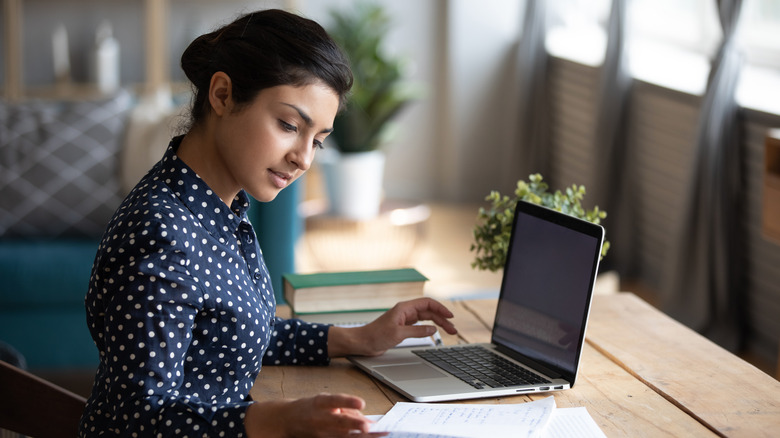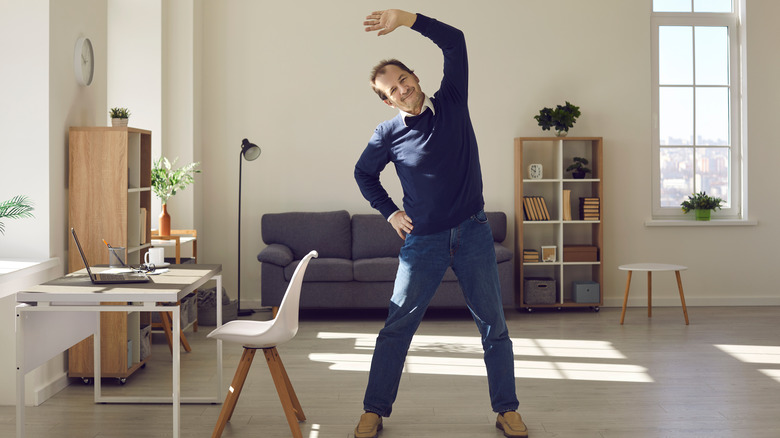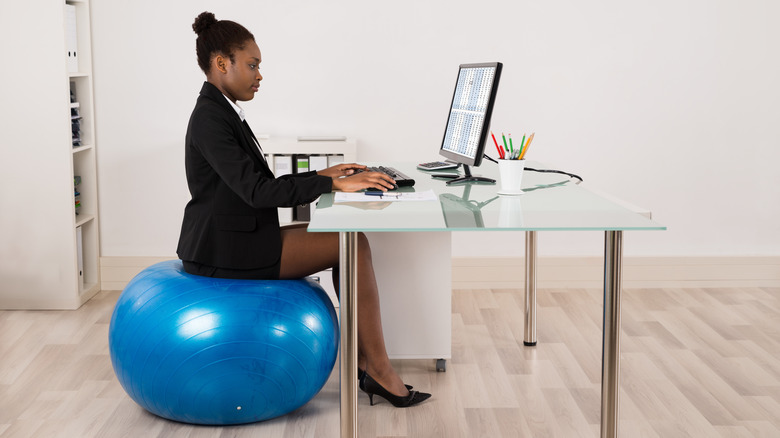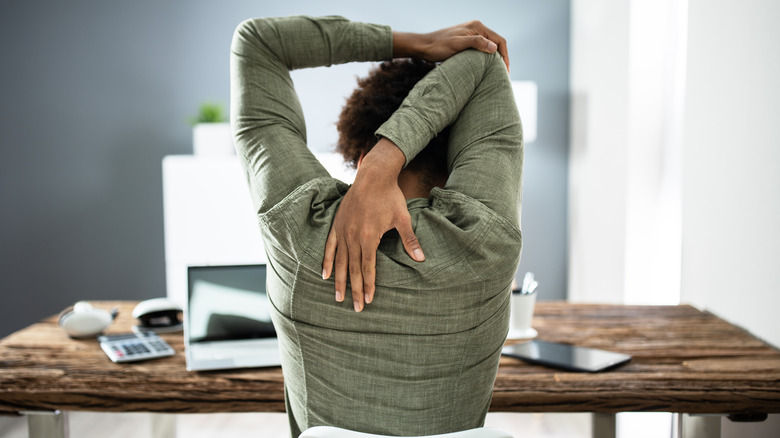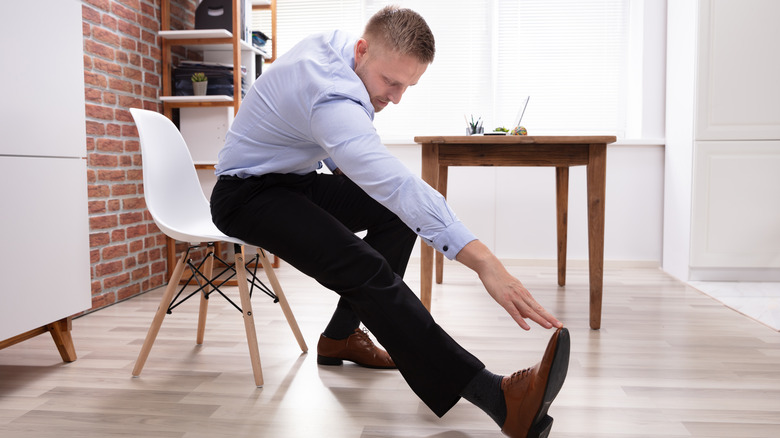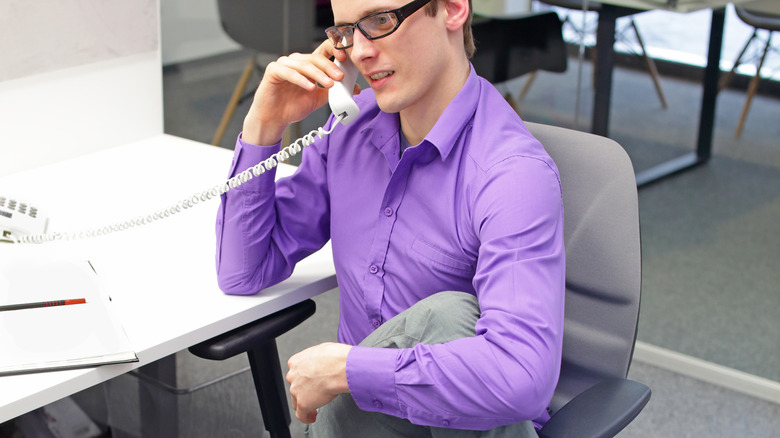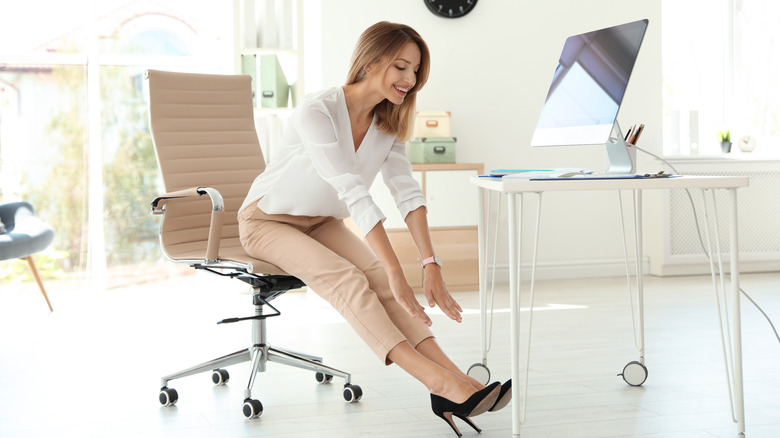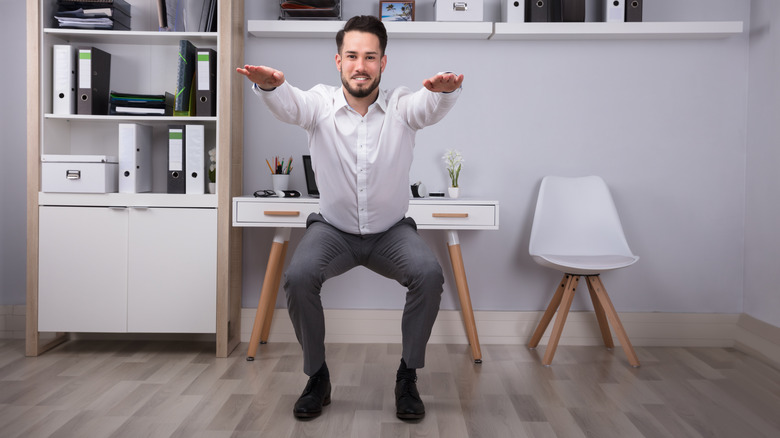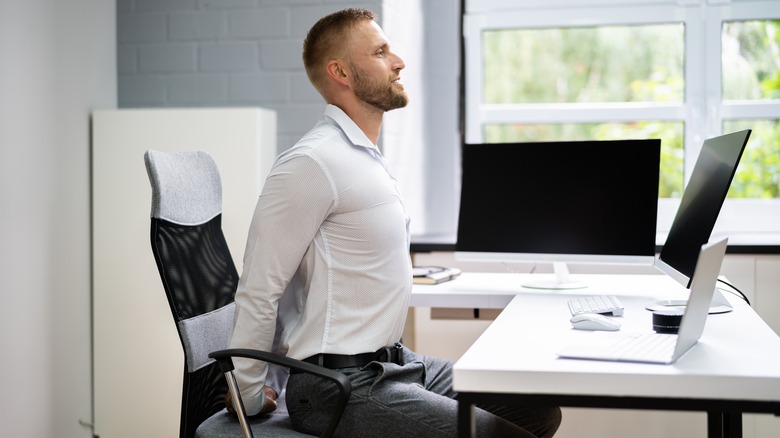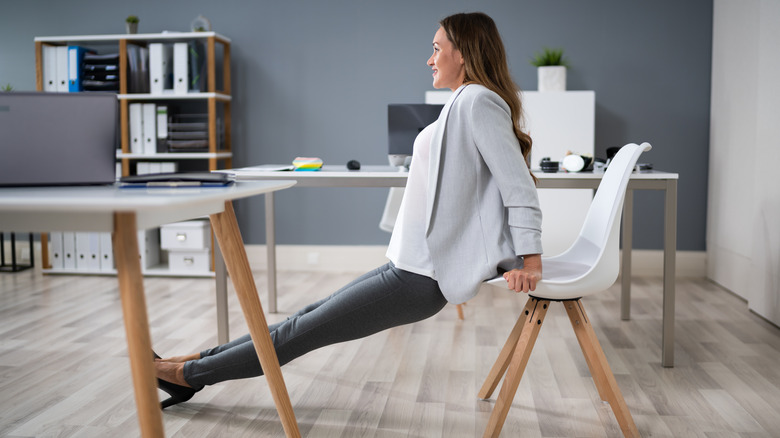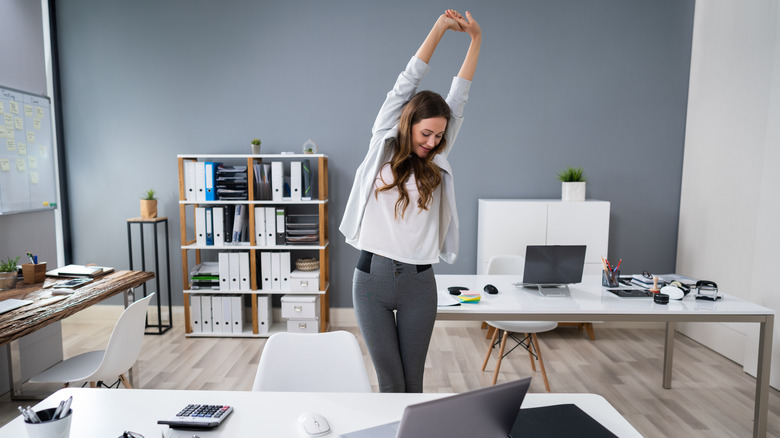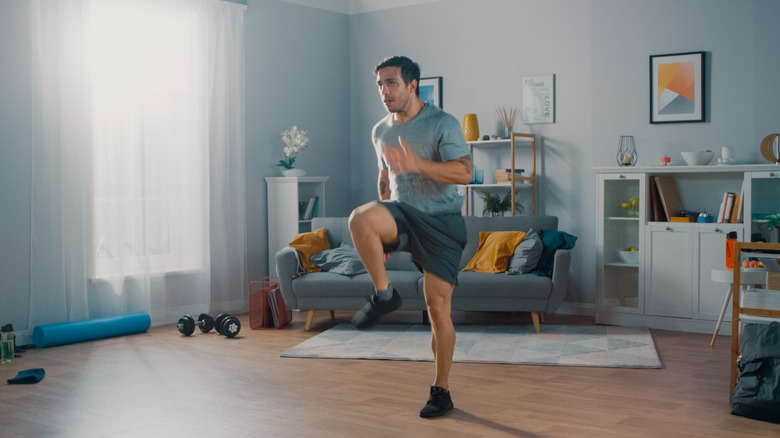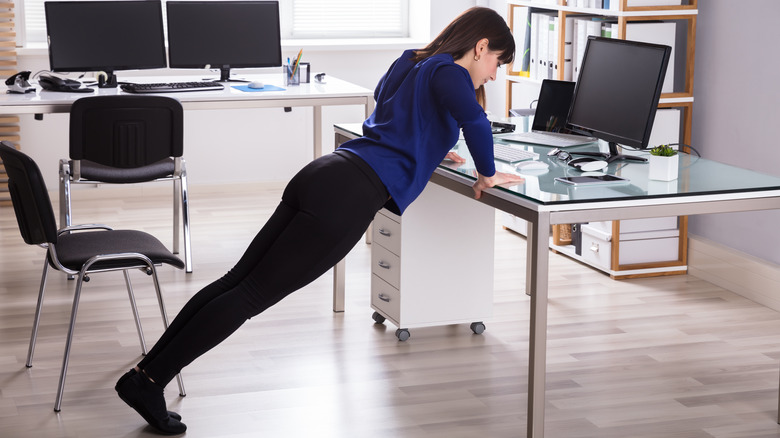The Best Exercises You Can Do While Sitting At Your Desk
A 2019 study published in the Journal of the American Medical Association found that Americans are sitting longer each day than they have in the past. The study found that the average adult sits for more than six hours a day, while the average adolescent sits for over eight hours a day.
According to Yale Medicine, sitting for long periods of time has been associated with myriad health issues. Studies have linked prolonged sitting to vascular problems, musculoskeletal problems including low back pain and osteoporosis, heart disease, and even cancer. Unfortunately, many people have jobs that require them to sit for long periods of time, putting them at risk for all the health issues that come with inactivity.
One of the best ways to counteract the ill effects of sitting for hours on end is to get up and move regularly. According to the Mayo Clinic, experts suggest getting some movement in every 30 minutes or so. If you're thinking to yourself, "I can't go for a walk every 30 minutes! I'd never get anything done," fear not! There are plenty of ways you can get some movement in, right at your desk.
Benefits of desk-ercise
Dr. Francisco Lopez-Jimenez, director of preventive cardiology at the Mayo Clinic, wrote an editorial for the European Heart Journal in which he argued that focusing on small bursts of movement throughout the day was a more effective approach to changing sedentary lifestyles than encouraging people to exercise several times a week. He suggested that if people want to improve their health, they should start by standing more. In an interview with CNN, Lopez-Jimenez said that engaging the muscles throughout the day could lower cholesterol, as well as the risk of heart disease and diabetes.
According to Psychology Today, taking a movement break also makes you better at your job. Taking a quick break to stretch, do some simple exercises, or take a quick walk can improve your motivation when you start working again, create clarity around tough decisions, give you a new perspective on your work, and allow you to integrate the information you need to work with.
Taking a movement break can also improve your focus and concentration. According to a study published in the medical journal Cognition, when people took a break and did an activity that used a different part of their brain, they had more focus when they returned to the original task. So, doing a drastically different activity, like moving your body, will help you return to work more focused.
Try adding some of these desk-ercises to your daily routine to get some movement in throughout the day.
Sit on an exercise ball for a bit
According to Livestrong, completely replacing your chair with an exercise ball isn't a great idea, but sitting on one for short periods of time provides a great opportunity for movement. Just sitting on the ball will engage your muscles. But if you want a bit more movement, you can do some simple exercises.
Verywell Fit suggests doing some ball circles, ball marches, ball balances, and ball walks. To do the ball circles, start by sitting on the center of the exercise ball, then start rolling your hips to the right. Continue moving your hips until you've made a full circle, and for 10-20 circles. Then, switch directions.
To do the ball marches, sit on the center of the ball and then lift one leg with your knee bent. Lower that leg and then lift the opposite leg. Keep alternating legs and marching for one to two minutes at a time.
For the ball balances, extend your leg out in front of you and hold while you balance on the ball. Switch legs and repeat for five to 10 reps.
Ball walks can't be done while you're working, but they're perfect for a quick break. Sit on the center of the ball and then start to walk your feet away from the ball. As you do, roll down the ball until it's under your shoulders. Then, walk your feet back toward the ball until you're sitting on it again. Repeat for 10-15 reps.
Stretch out your upper body
Neck and shoulder pain are common ailments for people who sit at work, according to Healthline. Hunching over a computer leads to poor posture, which can lead to aches and pains, or even musculoskeletal disorders. So, it's important to stretch out your upper body regularly through the day. Healthline suggests doing triceps stretches, side bends, and shoulder stretches to keep limber and stave off aches and pains.
For the triceps stretch, lift one arm until it's parallel with the side of your head, then bend at the elbow so your hand is behind your head. Grab the elbow with the opposite hand to deepen the stretch. Hold for a bit, then switch arms.
Side bends are great for stretching your arms and shoulders as well as your torso. Sit in the center of your chair with a straight back and then lean your upper body to one side. Reach your arm over your head, as if you're reaching for the wall. Hold for a bit, then come back to center and do the stretch on the other side.
Shoulder stretches help counteract the posture we assume when we sit over a computer all day. Sitting on the edge of your chair, grab the back of the chair with both hands so your arms are stretched out behind you. Arch your back and spread out the front of your chest, leaning a bit forward and pulling on the chair to deepen the stretch.
Stretch out your lower body
Dr. C Redding, a chiropractor currently practicing in Pennsylvania, is intimately familiar with the ways that sitting all day impacts our lower halves. In a blog post, Redding wrote that when we sit all day long, the muscles in our lower bodies get stiff and tight, leading to aches and pains. Redding suggests doing a few simple stretches, including seated hamstring stretches, seated figure four, and ankle rolls throughout the day to keep your lower body strong and loose.
For the seated hamstring stretch, sit on the edge of your chair and then stretch one leg out in front of you with your heel on the ground. Lean forward at the hip and reach down your leg. If the stretch is too intense, try bending your knee a bit. Hold for a bit and then sit up and switch legs.
The figure four stretch targets your hips and glutes. Sit in the middle of your chair and lift one leg. Place your ankle on your opposite thigh, creating a "4" shape with your legs. Then, lean forward. Hold for a bit, and then switch legs.
Ankle rolls are just about the easiest stretch you can do while working. You don't even have to stop typing! Just lift your leg and rotate your foot, making small circles. Do 10-15 in one direction and then switch directions. Then lower your leg and repeat the stretch with your other ankle.
Stretch out your back and core
Back pain is one of the most common ailments in the United States, per the American Chiropractic Association. According to a study published in the American Journal of Epidemiology, regular movement and stretching is the best way to both prevent and treat lower back pain. George Chiang, an ergonomist and the chief editor at Ergonomic Trends, suggests doing a seated pigeon pose, seated forward folds, and seated downward facing dog throughout the day to keep your back and core loose and pain free.
For a seated pigeon pose, cross one leg over the other. Sit up straight, and then twist your torso to the same side as the crossed leg. Put both hands on the knee of the crossed leg and gently pull for a deeper stretch. Hold for a bit and then switch legs.
For the seated forward fold, sit firmly in your chair, then bend at the hips, letting your torso rest on your thighs. Stretch out your arms and reach for your toes. Hold for a bit, and then slowly sit back up.
Seated downward dog is a great stretch for your back as well as your shoulders and arms. Place your palms on the edge of your desk. Move your chair away from your desk as you lean forward. Keep going until your arms are straight out in front of you. Then, lean forward a bit more. Hold for a bit and then slowly sit back up.
Strengthen your upper body
We all know how hard it is to fit in a workout when we're working and maintaining some semblance of a social life. If you're just too busy to hit the gym and lift some weights, you might want to try some simple strength training at your desk.
Joe Stankowski, a certified personal trainer, gave Men's Journal a simple routine for those who want to work their upper body while they're stuck at their desks. To work your arms and shoulders, Stankowski suggests some isometric biceps curls, isometric triceps pushdowns, and shoulder abductions.
For the biceps curls, bend at the elbow until your arm makes a 90 degree angle. Then, place your hand under the edge of your desk and push up while contracting the muscles, hold for six to 10 seconds, and then repeat six times on each arm.
For the triceps pushdowns, make a fist and put the side of your hand against your desk with your elbows bent to 90 degrees. Push into the desk as you lift your triceps. Hold for six to 10 seconds and repeat for six reps.
The shoulder abductions start with both arms stretched out in front of you. Slowly open your arms until they're straight out at your sides. Pinch your shoulder blades together and hold for six to 10 seconds. Bring your arms back in front of you, and repeat for 6 reps.
Strengthen your core
Having a strong core may help alleviate some of the back pain that comes from sitting for extended periods of time, personal trainer Camilla Bazley told Elle Australia. That's one of the reasons she came up with a core strengthening routine that people can do without even leaving their desks. She suggests doing five rounds of seated toe taps, seated jackknives, and seated crunches during your lunch break. However, these exercises can also be individually snuck into any part of your day.
The seated toe taps are the easiest to do while you're getting some work done. Sit firmly in your chair, lift one leg, and hold for 10 seconds while tightening your core. Then, put that leg down and lift the other leg. Alternate legs for 10 reps.
For the seated jackknives, sit on the edge of your chair and hold the seat with your hands. Then, reach both legs out in front of you as you lean back into the chair's backrest. Once fully extended, pull your knees back into your chest as you sit up in the chair. Repeat for 10 reps.
Seated crunches also start from sitting on the edge of your chair. Lean back into the backrest, and place your hands behind your head. Tighten through your core and slowly bring your torso to your thighs. Keep your core tight and lift back up. Repeat for 10 reps.
Strengthen your lower body
If work has you continually skipping leg day, fear not! Verywell Fit put together some simple lower body desk-ercises, including leg extensions, inner thigh abductions, and chair squats. Both the leg extensions and the inner thigh abductions can be done while you're sitting in your chair, typing away. The chair squats can be done while you read a document or listen to a long, boring conference call.
For the leg extensions, sit on the edge of your chair and tighten your glutes and core. Slowly lift one leg straight out in front of you until it's parallel to the ground. Hold it there for a few seconds and then lower the leg to the ground. Repeat for 16 reps and then switch to the other leg.
The inner thigh abductions require one piece of equipment. Luckily, it's something you probably have lying around on your desk — a coffee cup or water bottle. While sitting firmly in your chair with your feet flat on the ground, place the cup or bottle between your knees. Squeeze your knees together as you engage your inner thighs. Soften the muscles a little, and then squeeze again. Repeat for 16 reps.
For the chair squats, plant your feet firmly on the ground and then lift your glutes off the edge of your chair. Hold in a squat position for a few seconds, then stand up. Lower back into the squat position and hold. Repeat for 16 reps.
Sneak in a full body strength workout without leaving your chair
On those days when you're basically chained to your chair, try this full-body routine from Shape Magazine.
Start by working your arms and glutes. Sit on the edge of your chair and grab the sides of the seat with your hands. While you tighten your glutes, push into your hands and extend your arms, then release. Do 30 quick reps.
Next, do some seated jumping jacks. Sit on the edge of your chair with your knees bent and your arms bent by your sides. Extend your legs out until they make a V and bring your arms up over your head. Then, return to the starting position. Do 30 quick reps.
Then, sit on the edge of your chair with your knees bent for this leg lift and core twist combo. Raise one leg straight out in front of you, twist your torso in the direction of the raised leg, and return to start. Do 20 reps on one side, and then switch.
Finish up with some chair running. Sit on the edge of your chair, engage your core, and then lean back until your shoulders are on the backrest. Then, straighten your legs and lift them slightly off the ground. From there, bring one knee into your chest as you pump your arms, like you do when running. Straighten the bent leg, then bend the other knee in. Quickly alternate legs while pumping your arms, simulating running.
Use your desk and chair
These exercises from Healthline show you how to use your desk and chair as gym equipment to do exercises like triceps dips, pushups, and pistol squats.
For the triceps dips, stand with your back to your desk or chair (as long as your chair doesn't have wheels), then place the heel of your palm on the edge of your chair or desk. If you're using a chair, lower yourself down until your legs are out in front of you with your knees bent. If you're using a desk, walk your feet out in front of you so your legs are straight and you're leaning into your hands. Then, slowly bend your elbows and let your glutes drop toward the floor. Hold for a few seconds and then push your arms back to straight. Repeat for 10 reps.
You can also do some desk pushups. Place your hands on the edge of your desk, then walk your feet back until you're in a plank position. Bend your arms to slowly lower your chest toward your desk. Then, straighten your arms. Do 10 reps.
To do the pistol squats, sit in your chair with one leg firmly on the ground, then raise the other leg. Slowly stand up by pressing into the foot that's on the ground, then slowly lower back into your chair. Do five reps on each side.
Stand up and get moving
Every so often, you do need to actually get out of your chair and move your body. When that time has come, you can do some movements like standing leg extensions, standing twists (via Fitbit), stretch squats, and calf raises (via Spartan).
For the standing leg extensions, stand tall with equal weight in your feet. Engage your core, then lift one leg straight behind you, engaging your glutes as you lift. Then, return the leg to the floor. Do 12-25 reps, then switch legs.
Standing twists work your legs and core. Stand tall and then bend one knee up until it's even with your hips. Then, engage your core and twist your torso toward the leg that's raised. Hold for 10 seconds, then return to standing and switch sides.
For the stretch squats, stand with your legs a little wider than hip distance apart. Extend both arms overhead so they make a V. Then, engage your core and glutes as you sink down into a deep squat. Hold for a few seconds at the bottom and then stand up. Repeat for eight to 12 reps.
Standing calf raises are a simple but intense exercise. Stand with both feet firmly on the ground, engage your calf muscles, and then raise up onto your tiptoes. Hold for a few seconds, and then lower your heels and relax. Repeat for 12-15 reps.
60-second cardio
You can also get some quick cardio in while you take a break from sitting and get on your feet. Set a timer for 60 seconds and then try some of these cardio exercises recommended by WebMD.
Jumping jacks are a classic cardio buster. Take a few steps back from your desk and stand tall. When the timer starts, jump your legs out until they make a V and swing your arms up until they touch over your head. Then, jump your feet back together and swing your arms down by your side. Repeat these movements as quickly as possible for a full minute.
Running in place is also great cardio. Stand a bit away from your desk, and when the timer starts, begin lifting one foot then the other off the ground as if you were running. Try to get your knees as high as possible. Hold your arms bent at your sides and swing them with the rhythm of your "running" pace to get more of a full body workout. Continue until the timer goes off.
You can also simulate jumping rope for a great cardio workout. Position your arms as if you're holding a jump rope. Then, start to move your arms as if you're swinging the jump rope. As you do, either jump in place or alternate hopping from one foot to the other. Continue these jumps or hops as quickly as possible for the entire minute.
Getting some movement away from your desk
Though it often feels like we absolutely can't get away from our desks during the workday, it's actually really important to leave your desk from time to time. Of course, your body will benefit from the movement, but your work will benefit as well. A study published in the Journal of Experimental Psychology found that walking, especially outside, measurably boosted people's creativity. So, getting away from your desk can actually help you come back with more creativity to tackle your work.
Brian Parr, an expert in Exercise and Sports Science, spoke with LifeHacker and revealed some other benefits of getting movement away from your desk. He said that getting away from your computer for some movement can help reduce strain on both your eyes and your wrists, which are common ailments caused by working on a computer for long periods of time.
Parr suggests making a schedule for your workday that includes frequent movement breaks, some at the desk and some away from the desk. The movement breaks away from your desk don't have to be long or intense. You can walk to the break room and stand while you drink some coffee. You can do a few laps around the office. You can do a few laps up and down the stairs. Or you could get outside for a quick walk around the building and get some fresh air.
How often should you sneak in some desk-ercises?
There's no hard and fast rule about how often you should get up from your desk and take a movement break. However, the general recommendation is that we should be getting some desk-ercise in a lot more frequently than we think we should.
Parr told LifeHacker that people who work at a desk job should be taking a movement break every half hour! He suggested that for every 30 minutes of work you do, you should be taking a five-minute movement break to reset your body. He recommended doing different types of activities on each movement break to keep your body strong and ache-free. So mix up stretching, strength training, and cardio exercises each half hour throughout your day.
Dr. Jasmine Marcus, a physical therapist practicing in New York, gave PopSugar some slightly different guidance. Though she said that it's great to get up and move a little every half hour, moving once every hour or two is also fine. Marcus emphasized that two hours is the maximum amount of time that we should be sitting before taking a movement break.
So, the bottom line is that you should be spending some time moving, at your desk or away from your desk, at least every two hours. It's better to get up once or even twice an hour to get some movement in. It doesn't really matter what kind of movement you do — you just need to do some.

